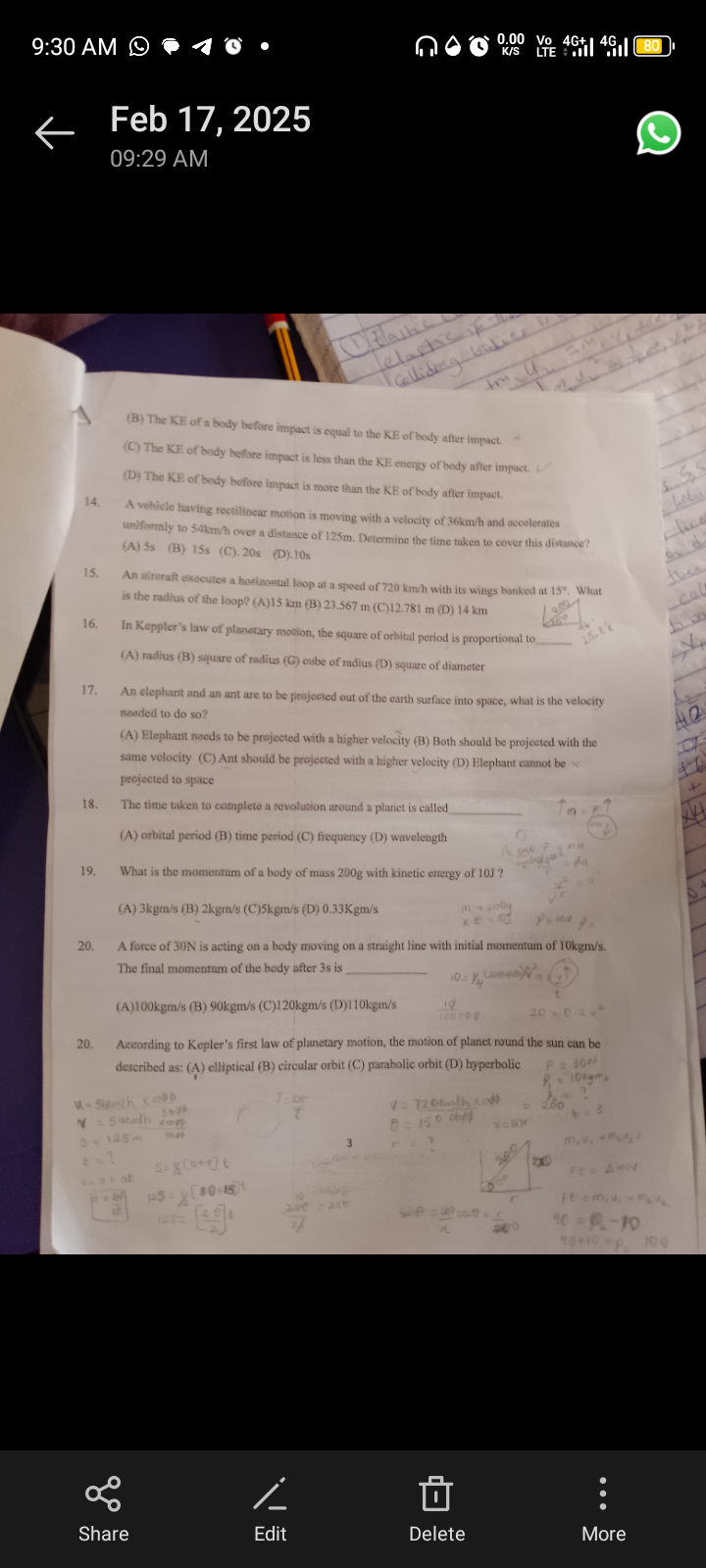See the processed text for the questions.

Understand the Problem
The image contains a series of physics questions, numbered 14 to 20. These questions cover topics such as kinematics, Kepler's laws, momentum, and energy. We need to identify the specific concepts each question addresses to classify them appropriately.
Answer
14. (D) 10s 15. (A) 15 km 16. (G) cube of radius 17. (B) Both should be projected with the same velocity 18. (A) orbital period 19. (B) 2kgm/s 20. (A) 100kgm/s 21. (A) elliptical
Answer for screen readers
- (D) 10s
- (A) 15 km
- (G) cube of radius
- (B) Both should be projected with the same velocity
- (A) orbital period
- (B) 2kgm/s
- (A) 100kgm/s
- (A) elliptical
Steps to Solve
-
Question 14: Convert velocities to m/s Convert the initial velocity from 36 km/h to m/s: $v_i = 36 \frac{km}{h} \times \frac{1000 m}{1 km} \times \frac{1 h}{3600 s} = 10 m/s$ Convert the final velocity from 54 km/h to m/s: $v_f = 54 \frac{km}{h} \times \frac{1000 m}{1 km} \times \frac{1 h}{3600 s} = 15 m/s$
-
Question 14: Use the kinematic equation to find the time Use the equation $s = \frac{(v_i + v_f)}{2} t$, where $s$ is the distance, $v_i$ is the initial velocity, $v_f$ is the final velocity, and $t$ is the time. Plug in the values: $125 = \frac{(10 + 15)}{2} t$ Simplify: $125 = \frac{25}{2} t$
-
Question 14: Solve for time Solve for $t$: $t = \frac{125 \times 2}{25} = \frac{250}{25} = 10 s$
-
Question 15: Convert velocity to m/s Convert the speed from 720 km/h to m/s: $v = 720 \frac{km}{h} \times \frac{1000 m}{1 km} \times \frac{1 h}{3600 s} = 200 m/s$
-
Question 15: Use the formula for the radius of a banked turn The formula for the radius of a banked turn is $r = \frac{v^2}{g \tan{\theta}}$, where $v$ is the speed, $g$ is the acceleration due to gravity (approximately $9.8 m/s^2$), and $\theta$ is the banking angle. Plug in the values: $r = \frac{(200)^2}{9.8 \tan{15^\circ}}$
-
Question 15: Calculate the radius $r = \frac{40000}{9.8 \times 0.2679} \approx \frac{40000}{2.625} \approx 15238 m = 15.238 km \approx 15 km$
-
Question 16: Recall Kepler's Third Law Kepler's Third Law states that the square of the orbital period ($T^2$) is proportional to the cube of the semi-major axis (which is approximately the radius $r$ for a circular orbit). Therefore, $T^2 \propto r^3$
-
Question 17: Recall Escape Velocity The escape velocity is independent of the mass of the object being projected. It only depends on the mass and radius of the Earth.
-
Question 18: Define Orbital Period The time taken to complete a revolution around a planet is called the orbital period.
-
Question 19: Use the kinetic energy formula to find velocity The kinetic energy formula is $KE = \frac{1}{2}mv^2$, where $KE$ is kinetic energy, $m$ is mass, and $v$ is velocity. Convert mass from grams to kilograms: $m = 200 g = 0.2 kg$ Plug in the values: $10 = \frac{1}{2}(0.2)v^2$ Solve for $v^2$: $v^2 = \frac{10 \times 2}{0.2} = \frac{20}{0.2} = 100$ Solve for $v$: $v = \sqrt{100} = 10 m/s$
-
Question 19: Calculate momentum Momentum $p = mv$, where $m$ is mass and $v$ is velocity. $p = (0.2 kg)(10 m/s) = 2 kg \cdot m/s$
-
Question 20: Apply Impulse-Momentum Theorem The impulse-momentum theorem states that the impulse (force x time) is equal to the change in momentum: $F \Delta t = \Delta p = p_f - p_i$, where $F$ is the force, $\Delta t$ is the time interval, $p_f$ is the final momentum, and $p_i$ is the initial momentum. Plug in the values: $(30 N)(3 s) = p_f - 10 kg \cdot m/s$ $90 kg \cdot m/s = p_f - 10 kg \cdot m/s$
-
Question 20: Solve for the final momentum $p_f = 90 kg \cdot m/s + 10 kg \cdot m/s = 100 kg \cdot m/s$
-
Question 21: Recall Kepler's First Law Kepler's First Law states that the orbit of a planet around the Sun is an ellipse with the Sun at one of the two foci.
- (D) 10s
- (A) 15 km
- (G) cube of radius
- (B) Both should be projected with the same velocity
- (A) orbital period
- (B) 2kgm/s
- (A) 100kgm/s
- (A) elliptical
More Information
Questions 14 through 20 cover fundamental physics concepts:
- Question 14: Deals with kinematics, specifically uniformly accelerated rectilinear motion.
- Question 15: Involves circular motion and banking angles.
- Question 16: Tests knowledge of Kepler's laws of planetary motion.
- Question 17: Relates to the concept of escape velocity.
- Question 18: Defines the term "orbital period."
- Question 19: Calculates momentum using kinetic energy.
- Question 20: Applies the impulse-momentum theorem.
- Question 21: Asks about Kepler's first law.
Tips
- Question 14: Forgetting to convert units (km/h to m/s) can lead to an incorrect answer.
- Question 15: Incorrectly applying the formula or using the wrong angle can lead to errors.
- Question 19: Incorrectly applying or manipulating the formulae for kinetic energy and momentum.
- Question 20: A common mistake is forgetting to add the initial momentum when calculating the final momentum.
AI-generated content may contain errors. Please verify critical information